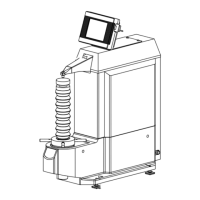No. 99MBG518A
A-13
PART A : 4 Hardness Test Methods
■Thickness of the specimen
The thickness of the specimen should be at least eight times the depth of the indent. The depth of the
indent can be calculated by the following formula.
-
2
2
11
2 D
dD
=
or
DH
h
π
=
-
h:
Depth of indent [mm]
F:
Test force [N]
D:
Diameter of indenter [mm]
H:
Brinell hardness of the specimen
d:
Indent diameter [mm]
■Distance to the edge of the specimen from the center of the indent
The distance to the edge of the specimen from the center of the indent must be 2.5d or more (d: diame-
ter of indent), and the distance between centers of indents must be 3d or more.
■Indent diameter
Select an appropriate test force in accordance with the material so that the diameter of the indent (d) is
0.24D to 0.6D (D: diameter of the indenter).
4.2.3 Test Force (Brinell Hardness Test)
Hardness test Hardness symbol Carbide ball indenter Test force [N]
Brinell
HBW 10/100 ø10 980.7
HBW 5/125
ø5
1226
HBW 5/62.5 612.9
HBW 5/25 245.2
HBW 2.5/187.5
ø2.5
1839
HBW 2.5/62.5 612.9
HBW 2.5/31.25 306.5
HBW 2.5/15.625 153.2
HBW 2.5/6.25 61.29
HBW 1/30
ø1
294.2
HBW 1/10 98.07
These explanations are provided based on the descriptions of "JIS Z 2243: Brinell hardness test – Test
method".
For details, see
"JIS Z 2243: Brinell hardness test – Test method".

